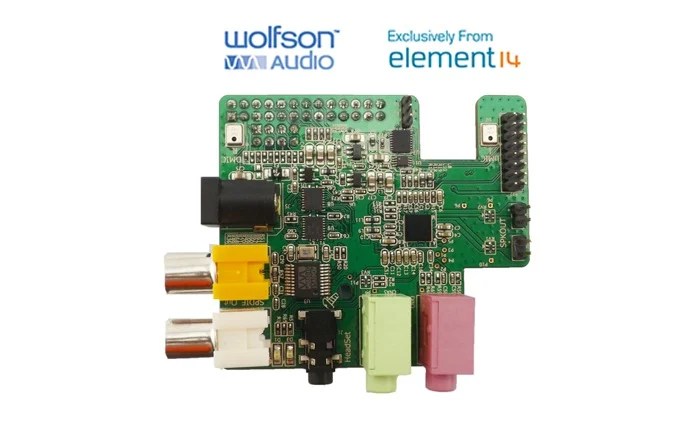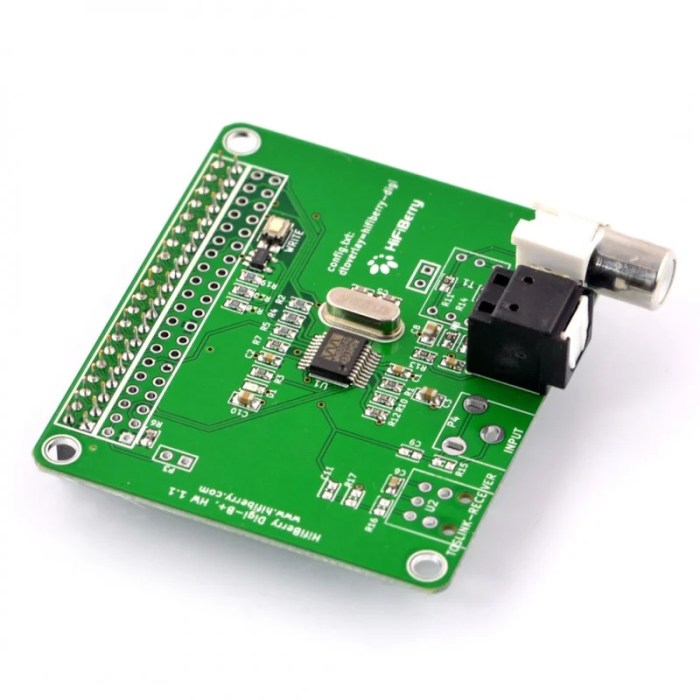Introduction to Raspberry Pi Sound Cards
Raspberry Pi sound cards are essential components for a variety of projects, allowing you to add audio capabilities to your Raspberry Pi. They enable you to play music, record audio, and even control devices with your voice.
Sound cards provide a bridge between your Raspberry Pi and external audio devices, such as speakers, microphones, and headphones. They are designed to handle the analog-to-digital conversion of audio signals, allowing your Raspberry Pi to process and understand the audio data.
Types of Raspberry Pi Sound Cards
Sound cards come in various forms, each with its own advantages and disadvantages. Here’s a breakdown of some popular types:
- USB Sound Cards: These are the most common type, offering flexibility and portability. They connect to your Raspberry Pi via a USB port, and most models are compatible with all Raspberry Pi models. Examples include the Creative Sound BlasterX Kratos S5 and the ASUS Xonar U7.
- HAT Sound Cards: HATs (Hardware Attached on Top) are designed specifically for Raspberry Pi and connect directly to the GPIO pins. They provide a more integrated solution and are often equipped with additional features like amplifiers and digital-to-analog converters (DACs). Examples include the Adafruit I2S DAC and the Pimoroni pHAT DAC.
- Built-in Sound Cards: Some Raspberry Pi models, such as the Raspberry Pi 4, come with built-in sound cards. These cards are typically integrated into the motherboard and provide basic audio functionality. However, they may not offer the same level of performance or flexibility as dedicated sound cards.
Examples of Raspberry Pi Sound Card Projects
Sound cards open up a world of possibilities for Raspberry Pi projects:
- Music Playback: You can use a sound card to play music from your Raspberry Pi through speakers or headphones. You can set up a dedicated music server or use streaming services like Spotify or Pandora.
- Audio Recording: Sound cards enable you to record audio using a microphone. You can capture sound effects, create podcasts, or even use voice recognition software.
- Voice Control: By connecting a microphone to a sound card, you can create voice-controlled projects. You can use voice commands to control devices, play music, or even automate tasks.
Choosing the Right Sound Card
The Raspberry Pi is a versatile platform for many projects, including audio applications. However, the onboard audio capabilities may not be sufficient for some projects. That’s where external sound cards come in. Choosing the right sound card for your project depends on your specific needs and budget.
Sound Card Features and Specifications
This section will compare popular Raspberry Pi sound cards, highlighting their features and specifications.
| Sound Card | Audio Quality | Input/Output Options | Price |
|---|---|---|---|
| HiFiBerry DAC+ Pro | High-quality audio with support for 24-bit/192kHz sampling rates | 1 x analog stereo output, 1 x SPDIF output, 1 x I2S input | $75 |
| Allo Boss DAC | Excellent audio quality with support for 32-bit/384kHz sampling rates | 1 x analog stereo output, 1 x SPDIF output, 1 x I2S input | $100 |
| Volumio Zero | Good audio quality with support for 24-bit/192kHz sampling rates | 1 x analog stereo output, 1 x SPDIF output | $50 |
| RPi-DAC+ | Good audio quality with support for 24-bit/192kHz sampling rates | 1 x analog stereo output, 1 x SPDIF output | $30 |
| Sound Blaster Play! 3 | Decent audio quality with support for 24-bit/96kHz sampling rates | 1 x analog stereo output, 1 x optical output, 1 x microphone input | $40 |
Factors to Consider When Choosing a Sound Card
There are several factors to consider when choosing a sound card for your Raspberry Pi project.
- Audio Quality: The audio quality of a sound card is determined by its sampling rate, bit depth, and signal-to-noise ratio (SNR). Higher sampling rates and bit depths provide better audio fidelity, while a higher SNR indicates less noise.
- Input/Output Options: The number and type of input and output options will determine the versatility of the sound card. Some common options include analog stereo outputs, SPDIF outputs, I2S inputs, and microphone inputs.
- Price: The price of sound cards can vary widely depending on their features and specifications. It is important to consider your budget when choosing a sound card.
Sound Card Recommendations, Raspberry pi add on sound card
Here are some sound card recommendations based on different project needs:
- For high-fidelity audio applications: The HiFiBerry DAC+ Pro or Allo Boss DAC are excellent choices, offering exceptional audio quality and a wide range of input/output options.
- For budget-friendly audio applications: The Volumio Zero or RPi-DAC+ are good options, providing decent audio quality at an affordable price.
- For projects requiring microphone input: The Sound Blaster Play! 3 is a good choice, offering a microphone input in addition to analog and optical outputs.
Utilizing Sound Cards in Projects
Sound cards open a world of possibilities for your Raspberry Pi projects. They allow you to integrate audio input and output, enabling you to create interactive experiences, build audio-based systems, and manipulate sound in creative ways.
Playing Audio Files
Playing audio files is a fundamental function of sound cards. You can use Python libraries like `pygame` or `playsound` to play various audio formats, including MP3, WAV, and OGG.
“`python
import pygamepygame.mixer.init()
pygame.mixer.music.load(“audio.mp3”)
pygame.mixer.music.play()
“`
This code snippet demonstrates how to play an MP3 file using `pygame`. You can easily adapt it to play other audio formats by changing the file extension.
Recording Sound
Sound cards allow you to capture audio input, enabling you to record sound from microphones or other audio sources. Python libraries like `pyaudio` provide access to audio input streams.
“`python
import pyaudiop = pyaudio.PyAudio()
stream = p.open(format=pyaudio.paInt16, channels=1, rate=44100, input=True, frames_per_buffer=1024)while True:
data = stream.read(1024)
# Process the recorded audio data here
“`
This code snippet shows how to open an audio input stream using `pyaudio`. You can then process the recorded audio data in real-time, saving it to a file, or analyzing its content.
Controlling Audio Output
Sound cards enable you to control audio output volume, routing, and effects. You can use libraries like `alsaaudio` to manipulate audio output parameters.
“`python
import alsaaudiomixer = alsaaudio.Mixer(“Master”)
mixer.setvolume(50) # Set volume to 50%
“`
This code snippet demonstrates how to adjust the master volume using `alsaaudio`. You can explore other `alsaaudio` functionalities to control different aspects of audio output.
Building a Voice-Activated Alarm System
A voice-activated alarm system is a practical example of utilizing a sound card. The system can be triggered by a specific voice command, such as “alarm on.” You can achieve this by using a combination of libraries like `pyaudio` for recording, `SpeechRecognition` for speech recognition, and `playsound` for playing alarm sounds.
The system would involve the following steps:
- Record audio input using `pyaudio`.
- Use `SpeechRecognition` to transcribe the recorded audio into text.
- Check if the transcribed text matches the trigger phrase (e.g., “alarm on”).
- If the trigger phrase is detected, play an alarm sound using `playsound`.
Benefits of Using Sound Cards
Sound cards offer numerous advantages for audio processing and manipulation in Raspberry Pi projects.
- Enhanced Audio Quality: Sound cards often provide higher-quality audio input and output compared to the built-in audio capabilities of the Raspberry Pi.
- Increased Flexibility: They offer more control over audio routing, mixing, and effects, allowing you to create more complex and nuanced audio experiences.
- Real-Time Audio Processing: Sound cards enable real-time audio processing, allowing you to manipulate audio signals as they are being captured or played.
Advanced Sound Card Applications: Raspberry Pi Add On Sound Card
The Raspberry Pi’s versatility extends beyond basic audio playback and recording. With the right sound card, you can venture into complex audio projects, pushing the boundaries of audio processing and creative expression.
Digital Audio Workstations (DAWs)
Sound cards empower you to transform your Raspberry Pi into a powerful audio production hub. DAWs, software applications designed for recording, editing, and mixing audio, can be run on the Raspberry Pi with the help of a dedicated sound card. These sound cards provide the necessary audio interfaces and processing power to handle the demands of professional audio production.
- Low-latency Audio Input/Output: Sound cards with dedicated audio processing units (APUs) ensure minimal latency, crucial for real-time recording and playback. This minimizes the delay between audio input and output, allowing for smooth and responsive audio workflows.
- Multiple Input/Output Channels: Sound cards offer multiple input and output channels, enabling the simultaneous recording and playback of multiple audio sources. This flexibility allows you to work with multi-track recordings, instrument inputs, and surround sound setups.
- High-Quality Audio Conversion: Sound cards with high-quality analog-to-digital converters (ADCs) and digital-to-analog converters (DACs) ensure accurate audio conversion, preserving the integrity of your recordings and playback.
Real-Time Audio Processing
Beyond basic audio recording and playback, sound cards enable real-time audio processing, opening up a world of possibilities for audio effects, synthesis, and manipulation. Libraries and tools specifically designed for real-time audio processing on the Raspberry Pi allow you to create custom audio effects, synthesize sounds, and manipulate audio in real-time.
- Audio Processing Libraries: Libraries like PyAudio and PortAudio provide cross-platform interfaces for real-time audio input and output. These libraries allow you to write Python scripts to process audio data in real-time, enabling you to create audio effects, filters, and other audio manipulations.
- Real-Time Audio Synthesis: Libraries like FluidSynth allow you to synthesize sounds in real-time. You can create virtual instruments, generate soundscapes, and explore the world of audio synthesis using these libraries.
- Audio Effect Plugins: Sound cards can be used to run audio effect plugins, extending the capabilities of your DAW or audio processing software. These plugins can be used to add reverb, delay, distortion, and other effects to your audio.
Integration with Other Raspberry Pi Components
The Raspberry Pi’s modular nature allows you to seamlessly integrate sound cards with other components, creating interactive and innovative audio projects.
- Camera Integration: Combine a sound card with a Raspberry Pi camera module to create audio-visual projects. You can record audio alongside video, adding a new dimension to your video recordings. You can even trigger audio events based on the camera’s image recognition capabilities.
- Sensor Integration: Connect sensors like temperature, light, or pressure sensors to your Raspberry Pi and use the sound card to create audio feedback based on the sensor readings. This allows you to create interactive sound installations or sonify real-world data.
Raspberry pi add on sound card – So, there you have it! Raspberry Pi add-on sound cards are a versatile and affordable way to add audio capabilities to your projects. Whether you’re a music enthusiast, a tech tinkerer, or simply want to give your Raspberry Pi a voice, these sound cards are a game-changer. Get ready to unlock the full potential of your Raspberry Pi and let the sound of innovation take over!
Need a better audio experience for your Raspberry Pi projects? A dedicated sound card can give your little computer a serious audio upgrade. While you’re fiddling with your Pi, keep in mind that Apple is transferring its Chinese iCloud operations to a local firm next month , a move that could have implications for data privacy and security.
But hey, back to your Pi – those sound cards can really pump up the volume on your next DIY project!
 Standi Techno News
Standi Techno News

